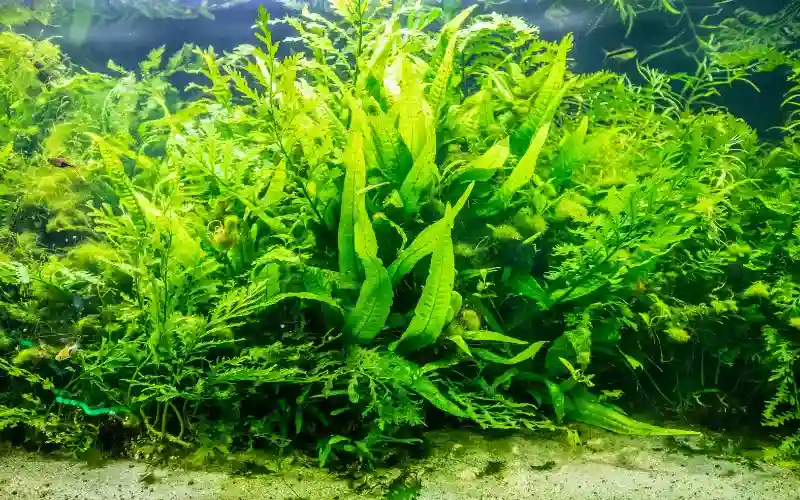As a plant enthusiast, you know that adequate lighting is crucial for healthy growth. The same applies to Java Fern, a popular aquarium plant that requires proper light conditions to thrive.
Java Fern’s light requirements are unique compared to other aquatic plants. Understanding its specific lighting needs is crucial for successful cultivation. This section will delve into the optimum light conditions required for the growth and development of Java Fern.
Key Takeaways:
- Java Fern requires specific light conditions for healthy growth.
- Proper lighting is crucial for successful cultivation of Java Fern.
- Understanding Java Fern’s lighting needs is crucial for providing the optimum light conditions.

Understanding Java Fern’s Lighting Needs
Java Fern has specific lighting needs that are crucial for its growth and development. Proper lighting helps the plant to photosynthesize, produce oxygen, and synthesize nutrients. In this section, we will go through the lighting guidelines, light intensity, and the best light for java fern growth.
Java Fern Lighting Guidelines
Java Fern thrives in low to medium light conditions with enough light to support photosynthesis, but not so much that it causes stress. The plant prefers diffused, rather than direct light. Direct sunlight can be too harsh and cause algae growth, which may harm the plant. Ideally, the plant should receive 8-10 hours of light each day in a consistent light cycle.
Java Fern Light Intensity
The correct light intensity is critical for the growth of Java Fern. Insufficient light will cause the plant to grow slowly, while too much light can cause light-stress, damaged leaves, or even lead to the death of the plant. A minimum of 40-50 PAR (Photosynthetically Active Radiation) is recommended for the plant to thrive. PAR refers to the spectral range of radiation that plants can use for photosynthesis.
Best Light for Java Fern Growth
There is no one-size-fits-all answer to the best light for Java Fern growth. However, fluorescent lighting is the most commonly recommended lighting source for the plant. Fluorescent bulbs emit low heat and provide a spectrum of light that is suitable for Java Fern’s growth. LED lighting can also be used, but it is important to pick a bulb that provides a suitable PAR range for the plant. Natural light from a window can also be effective if the window does not provide direct sunlight and the plant is not exposed to extreme temperature fluctuations.
Providing Optimal Light Conditions
Proper lighting is one of the crucial factors that affect the growth of Java Fern. The right lighting requirements for java fern will ensure that your plant grows healthy and vibrant. Here are some recommendations to create suitable lighting conditions for your Java Fern:
Natural Light
Java Fern thrives in moderate to low lighting conditions. If you prefer natural lighting, place your plant close to a window that gets partial sunlight. Avoid direct sun exposure, as it may lead to burned leaves and stunted growth. You can also use window blinds or sheer curtains to diffuse the light and create an ideal lighting condition.
Artificial Light Sources
If natural lighting is inadequate or unavailable, you can use artificial light sources, such as fluorescent, LED, and incandescent bulbs. These options are convenient, especially for indoor gardening. Choose bulbs with the appropriate spectrum to provide the necessary light intensity. For Java Fern, the ideal spectrum is in the range of 5000-7000K, which is considered a cool white or daylight spectrum.
| Light Type | Recommendation |
|---|---|
| Fluorescent | Choose cool white or daylight spectrum bulbs. Place the bulbs 6-8 inches above the plant for 10-12 hours a day. |
| LED | Choose LED bulbs that emit a full-spectrum light or cool white spectrum. Place the bulbs 6-8 inches above the plant for 10-12 hours a day. |
| Incandescent | Choose clear or frosted bulbs with a wattage of 40-60 watts. Place the bulbs 12-18 inches above the plant for 10-12 hours a day. |
Positioning
The placement of your Java Fern can significantly affect its growth. Position the plant near the light source to maximize light exposure. You can use a reflector or light stand to redirect the light towards the plant. Additionally, ensure that the light is evenly distributed, and all parts of the plant get adequate exposure to light. Rotate the plant regularly to ensure that all sides receive an equal amount of light.
Providing the proper lighting requirements for java fern is crucial for the plant’s growth and development. Follow these recommendations to ensure that your Java Fern grows healthy and vibrant.

Creating the Perfect Environment for Java Fern
While light is essential for the healthy growth of Java Fern, providing an optimal environment is equally important.
The ideal conditions for this plant include a temperature range of 68°F to 82°F (20°C to 28°C) and a relative humidity level of 50% to 80%. Keeping the plant within this range will help prevent stress and promote consistent growth. Additionally, water quality is crucial, and it is recommended to use dechlorinated or distilled water.
Other factors that contribute to the plant’s well-being include substrate, carbon dioxide levels, and nutrient availability. Java Fern prefers to be anchored in a substrate that contains a variety of nutrients to support its growth. If using a planted tank, supplementing the water with carbon dioxide may also benefit the plant.
| Java Fern Growth Factors | Ideal Conditions |
|---|---|
| Temperature Range | 68°F to 82°F (20°C to 28°C) |
| Relative Humidity Level | 50% to 80% |
| Water Quality | Dechlorinated or distilled water |
| Substrate | Contains nutrients to support growth |
| Carbon Dioxide Levels | Supplemented levels may benefit growth |
| Nutrient Availability | Regularly supplement water with essential nutrients |
Conclusion
Providing the perfect environment for Java Fern is critical for its overall health and growth. By optimizing various factors such as temperature, humidity, water quality, and nutrient availability, you can ensure your plant thrives.
Troubleshooting Common Light-related Issues
While Java Fern is generally a hardy and low-maintenance plant, it can experience light-related issues from time to time. Here are some common problems and solutions to help keep your Java Fern thriving:
Light Stress in Java Fern
Java Fern leaves can become pale or yellow when exposed to too much light. This is particularly common when the plant is first introduced to a new lighting environment, so it’s important to acclimate it gradually.
If you notice signs of light stress in your Java Fern, try reducing the light intensity or duration. Alternatively, you can move the plant further away from the light source. Be sure to monitor the plant closely and adjust as necessary.
Insufficient Lighting Conditions
If your Java Fern is not receiving enough light, you may notice stunted growth or yellowing leaves. This can be caused by factors such as inadequate light intensity or duration, or poor positioning of the plant.
Try increasing the duration or intensity of your light source, or moving the plant closer to a window if it’s not receiving enough natural light. You can also consider using artificial light sources, such as fluorescent or LED grow lights, to supplement natural light.
Remember that every plant is unique, so it may take some experimentation to find the optimal lighting conditions for your Java Fern. With patience and consistency, your plant will thrive and add a touch of natural beauty to your home or office.
Additional Tips for Java Fern Care
Beyond understanding the lighting needs of Java Fern, proper care and maintenance are crucial for ensuring its longevity and health. Here are some additional tips to keep in mind:
1. Fertilize appropriately
Java Fern is a slow-growing plant and does not require frequent fertilization. However, providing it with a nutrient source can help boost its growth rate. Choose a liquid or substrate fertilizer specifically designed for aquatic plants, and apply it sparingly, following the instructions provided.
2. Prune regularly
Pruning Java Fern is essential for maintaining its shape and preventing overcrowding. Use a sharp pair of scissors or pruning shears to trim away any yellow or damaged leaves, as well as excess growth. Be careful not to cut too much at once, as this can shock the plant.
3. Consider compatible companion plants
Java Fern can benefit from the presence of other aquatic plants in its environment. Consider adding some compatible species, such as Anubias or Cryptocoryne, to help absorb excess nutrients and provide a more diverse ecosystem for your aquarium.
4. Avoid overcrowding
While Java Fern can tolerate a wide range of growing conditions, it is important to avoid overcrowding in its environment. Allow ample space for each plant to grow and spread out, and avoid overcrowding with other species. This will prevent competition for resources and ensure optimal growth.
By following these tips and providing the proper care, your Java Fern will thrive and add a beautiful touch of green to your aquarium or terrarium.













Comments are closed.